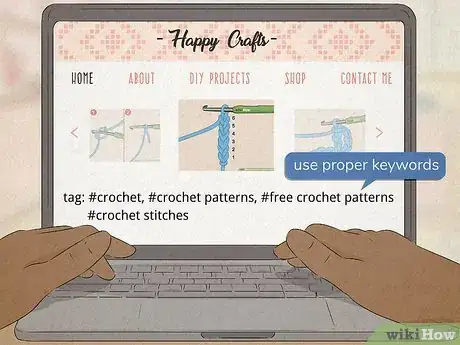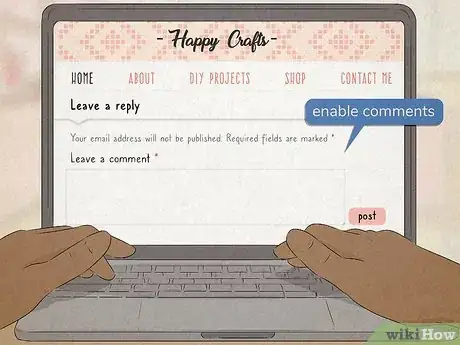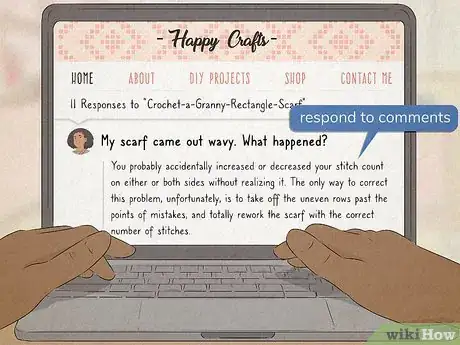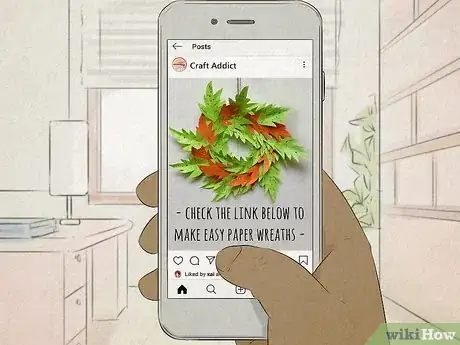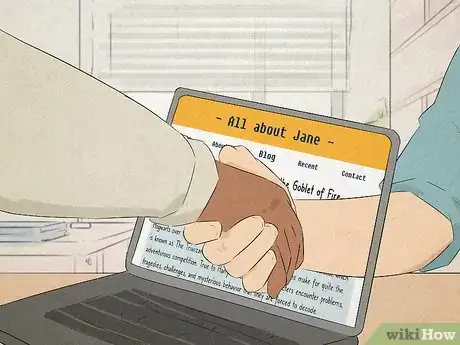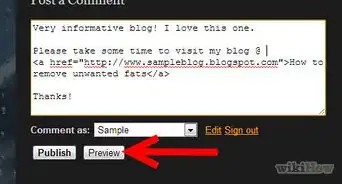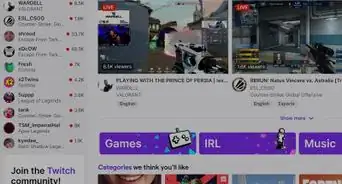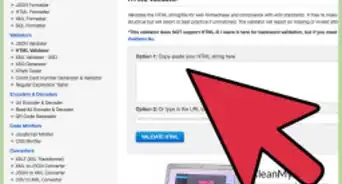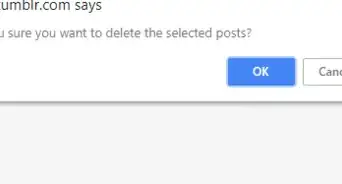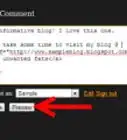This article was co-authored by Melissa Rodriguez and by wikiHow staff writer, Amber Crain. Melissa Rodriguez is a Marketing and Advertising Specialist and the Founder of Social Media Relations out of Los Angeles, California. With over 5 years of experience, she specializes in branding, content production, social media marketing, and public relations. Melissa holds BS degrees in Global Perspectives and Corporate Finance and Accounting from Bentley University.
There are 10 references cited in this article, which can be found at the bottom of the page.
wikiHow marks an article as reader-approved once it receives enough positive feedback. In this case, 87% of readers who voted found the article helpful, earning it our reader-approved status.
This article has been viewed 912,914 times.
Blogging is an amazing way to share information and make an impact. If you’re running one, chances are you want to reach a larger audience with your work. This might seem easier said than done, but don't worry—we'll walk you through the process and share plenty of tips and tricks to help you on your journey. Read on to learn how you can develop your own unique voice and style to better connect with more readers.
Steps
Developing Solid Content
-
1Pick a perspective to write from to set the tone and know your audience. Do you want to write from a personal, technical, academic, or professional perspective? Deciding your angle right away helps you set the tone for your writing, helps you stay focused, and gives you a good idea of who your likely audience is.[1]
- Personal blogs tend to focus on personal anecdotes and universal topics like cooking, crafting, and home improvement. It's best to focus on one main topic for your blog, but multiple topics could work if the topics are connected in some way.[2]
- For technical and professional blogs, use the same friendly tone you’d use to speak to coworkers and employers.
- Academic blogs are a bit more formal since you’re analyzing topics, using citations, and speaking to an audience of academics or professionals. Aim for a friendly tone that isn't overly casual or personal.[3]
-
2Use conversational language and include personal experiences. Think of blogging as a conversation between you and your reader. Stick with everyday language so it feels like you're having a chat rather than delivering a lecture to an audience. Include personal anecdotes and let your unique personality shine through![4]
- Technical, professional, and academic blogs aren't overly personal but the language still needs to be conversational to draw your readers in.
- If readers aren't leaving comments on your blog posts, your language might be too stiff. Try to loosen up the language a bit and write conversationally.
Advertisement -
3Post valuable, relevant content that educates or solves problems. Really think about what you’re putting out there as you create content. Does each blog post offer value to your reader? Is the information up-to-date and relevant? Does it teach readers something new?[5] Aim for "evergreen content," which is content that won't lose relevance over time. Great examples include:
- How-tos and tutorials
- Case studies
- Answering/solving specific questions/problems
- Complete glossary of a topic or niche
- Product lists or reviews[6]
-
4Stick to topics you’re familiar with so your blog feels reliable. Blog readers want informed, knowledgeable content written by someone who really knows their stuff! Focus on creating high-quality content and sharing trustworthy information.[7] You want your readers to see you as a trusted authority on the topic.[8]
Formatting Dynamic Posts
-
1
-
2Use keywords in your posts so people can find the blog easily. Writing blog posts is hard work and you definitely don’t want to get lost in a sea of similar blogs. Do keyword research that’s relevant to your topic before you start writing a new post.[11] Then, insert the best keywords into your content in a natural way to maximize your chances of readers finding your posts.[12]
- It's also a good idea to use relevant keywords in your post titles.
- Go with 1-2 strong long-tail keywords per blog post. Long-tail keywords are highly specific phrases containing 3-4 words. For example, if you're writing a post on how to get started with yoga at home, you might use long-tail keywords like "home yoga workouts" or "yoga poses for beginners."
- You could also choose one high-quality keyword to build your post around. Write the post and monitor the number of page visits for 30-60 days. Then, update the post to include another keyword and see if page traffic increases.
-
3Use short paragraphs so your posts are easy to read. Long paragraphs can look overwhelming on a screen. To avoid this, write in short, concise paragraphs that are 2-3 sentences long. Make sure each paragraph communicates a clear point.[13]
- Numbered lists and bullet points are great for breaking up text on the page and making the content easier to read.
-
4Include high-quality images to make blog posts more appealing. Readers love images! Lead with a relevant, eye-catching main image at the top of the post, which will be the thumbnail image when the post link is shared on social media or other blogs. Use relevant images that support, demonstrate, and break up your content.[14]
- Embedded videos are also helpful and appealing to readers.
Engaging Your Audience
-
1Blog frequently and consistently so readers look forward to your posts. Readers are more likely to return to your blog if you post new content on a regular basis. Create a posting schedule and stick to it! Posting weekly is a good goal to start with, but you definitely can post more often. The key is to be consistent.[15]
- If you're posting once a week, try to do it on the same day and around the same time every week. For example, you might post every Wednesday morning before noon.
- Try to get in the habit of writing every day, even if you don't post everything you write.
-
2Enable comments so your readers can post thoughts or questions. Most blog platforms allow you to decide if people can comment or not. Check your blog’s settings to make sure comments are enabled. The platform may allow more customization, but those settings are entirely up to you. Keep in mind that the easier it is for readers to comment, the more likely they are to do it![16]
- This is a great way to get feedback to see how people feel about your content![17]
- For example, your blog platform may let you decide whether people can comment anonymously or not. There's nothing wrong with allowing anonymous comments, but since you're trying to build a community of readers, the community might not appreciate random people dropping in to make comments with no accountability. Readers may be more likely to comment on posts if they don't have to divulge their identities, though, so there are definitely pros and cons to consider.
-
3Ask questions and encourage interaction to engage your readers. Raising thought-provoking questions in your posts and asking your readers to leave their answers in the comments section is a great way to open up a dialog with your audience. Keep an eye on each post's comment activity so you can get to know your readers better.[18]
- For example, readers may start comment threads to debate or share ideas, which in turn offers valuable insights about your audience. You might also get some ideas for future blog posts.
-
4Respond to comments to speak directly to your readers. If readers leave questions for you in the comments, answer them! If you have insight to offer about a reader comment, offer a response. If there’s a particularly lively comment thread going, drop in with your opinion or ask questions about their ideas.[19]
- Conversing on a personal level makes readers feel involved and part of a community.
- Monitor comment threads for aggressive or negative interactions and step in if you need to restore order.[20]
- If a reader becomes a frequent troublemaker, you may be able to turn off their ability to comment. Check your blog settings for more information.
Expanding Your Audience
-
1Develop a strong social media presence for maximum impact. Millions of people use social media every day, so being active on Facebook, Twitter, and Instagram is crucial for growing your audience.[21] Post and share relevant, intriguing content that you know your readers are interested in and build a relationship with them.[22] Great ways to develop your social media presence include:
- Sharing interesting facts or trends
- Posting daily tips or helpful suggestions
- Sharing videos or links that are useful/interesting/entertaining to your audience
- Posting blog updates or insights
-
2Share links to your blog posts with your social media followers. Post links to your new blog posts so your friends/followers know there’s new content to check out. This also makes it easier for your friends/followers to share or retweet your post links. Then, all of their friends and followers will see them, too! This is a powerful way to reach a larger audience.[23]
- Check out relevant Facebook groups and share your content there. Be sure to stick around and engage with group members and commenters there, too. Encourage them to follow you on Facebook and Twitter while you’re there!
-
3Build relationships with and share content by other bloggers. Follow other influential bloggers in your niche and comment on their posts. Be supportive of them and share their content with your followers. Build a sincere relationship with other bloggers and hopefully they’ll start sharing and supporting your posts, as well.[24]
- You can definitely branch out within your niche to make connections. For example, if you blog about paleo desserts, reach out to bloggers who focus on the paleo lifestyle, paleo diets, and paleo recipes.
- This can help you reach a brand-new or totally different audience.
- Asking another blogger to write a guest post on your blog is a great way to support them and start a relationship. Hopefully, they’ll ask you to do the same one day.
-
4Monitor your stats and use them to make impactful changes. Most blog platforms show analytics and statistics for things like your daily, weekly, and monthly site traffic, how readers are finding your blog, audience engagement, and so on. You can use this information to tailor your posts to your readers’ needs and tweak anything that’s not working to optimize your blog.[25]
- For example, if posts get more visitors when you share the link after lunch rather than before, change your posting schedule and sharing habits to reflect that.
Expert Q&A
-
QuestionHow long does SEO take to work?
 Melissa RodriguezMelissa Rodriguez is a Marketing and Advertising Specialist and the Founder of Social Media Relations out of Los Angeles, California. With over 5 years of experience, she specializes in branding, content production, social media marketing, and public relations. Melissa holds BS degrees in Global Perspectives and Corporate Finance and Accounting from Bentley University.
Melissa RodriguezMelissa Rodriguez is a Marketing and Advertising Specialist and the Founder of Social Media Relations out of Los Angeles, California. With over 5 years of experience, she specializes in branding, content production, social media marketing, and public relations. Melissa holds BS degrees in Global Perspectives and Corporate Finance and Accounting from Bentley University.
Marketing & Advertising Specialist SEO integration isn't some overnight hack to make your blog blow up in popularity. It's much more of a long-term way to build up your audience and get more views. How long it takes to start helping your blog is going to depend on a variety of factors though, and there's no way to know for sure how long it will take.
SEO integration isn't some overnight hack to make your blog blow up in popularity. It's much more of a long-term way to build up your audience and get more views. How long it takes to start helping your blog is going to depend on a variety of factors though, and there's no way to know for sure how long it will take. -
QuestionHow long will it take to become well-known for my blog?
 Melissa RodriguezMelissa Rodriguez is a Marketing and Advertising Specialist and the Founder of Social Media Relations out of Los Angeles, California. With over 5 years of experience, she specializes in branding, content production, social media marketing, and public relations. Melissa holds BS degrees in Global Perspectives and Corporate Finance and Accounting from Bentley University.
Melissa RodriguezMelissa Rodriguez is a Marketing and Advertising Specialist and the Founder of Social Media Relations out of Los Angeles, California. With over 5 years of experience, she specializes in branding, content production, social media marketing, and public relations. Melissa holds BS degrees in Global Perspectives and Corporate Finance and Accounting from Bentley University.
Marketing & Advertising Specialist Don't focus too much on this when you're just starting out. Just do your best to put out great content. Work on your writing and try to maintain a consistent schedule when it comes to your output.
Don't focus too much on this when you're just starting out. Just do your best to put out great content. Work on your writing and try to maintain a consistent schedule when it comes to your output. -
QuestionWhen starting a blog, how often should I post new content?
 Community AnswerReally whatever works for you is fine but I'd recommend about twice a week when you are first starting out. That way you're taking your time to make good quality posts. After getting a short following, you can increase or decrease posting as it suits you.
Community AnswerReally whatever works for you is fine but I'd recommend about twice a week when you are first starting out. That way you're taking your time to make good quality posts. After getting a short following, you can increase or decrease posting as it suits you.
Warnings
- Don't be unnecessarily rude to or argue with your audience.⧼thumbs_response⧽
- Never include personal information, like your home address or phone number, in blog posts.⧼thumbs_response⧽
References
- ↑ Melissa Rodriguez. Marketing & Advertising Specialist. Expert Interview. 23 April 2021.
- ↑ https://writingcenter.unc.edu/tips-and-tools/blogs/
- ↑ https://www.hamilton.edu/academics/centers/writing/writing-resources/writing-academic-blogs
- ↑ https://copyblogger.com/secrets-of-popular-blog/
- ↑ https://www.theguardian.com/culture-professionals-network/culture-professionals-blog/2011/nov/17/top-tips-successful-blog
- ↑ https://allbloggingtips.com/become-a-famous-blogger/
- ↑ Melissa Rodriguez. Marketing & Advertising Specialist. Expert Interview. 23 April 2021.
- ↑ https://hbr.org/2012/12/if-youre-serious-about-ideas-g
- ↑ https://ischool.syr.edu/how-to-write-an-effective-blog-post/
- ↑ https://writing.wisc.edu/handbook/assignments/writingblogpost/
- ↑ Melissa Rodriguez. Marketing & Advertising Specialist. Expert Interview. 23 April 2021.
- ↑ https://www.forbes.com/sites/sujanpatel/2016/08/24/8-ways-to-promote-your-blog-content/?sh=174e79fc2dab
- ↑ https://ischool.syr.edu/how-to-write-an-effective-blog-post/
- ↑ https://ischool.syr.edu/how-to-write-an-effective-blog-post/
- ↑ https://allbloggingtips.com/become-a-famous-blogger/
- ↑ https://www.theguardian.com/culture-professionals-network/culture-professionals-blog/2011/nov/17/top-tips-successful-blog
- ↑ Melissa Rodriguez. Marketing & Advertising Specialist. Expert Interview. 23 April 2021.
- ↑ https://writingcenter.unc.edu/tips-and-tools/blogs/
- ↑ https://writingcenter.unc.edu/tips-and-tools/blogs/
- ↑ https://www.theguardian.com/culture-professionals-network/culture-professionals-blog/2011/nov/17/top-tips-successful-blog
- ↑ Melissa Rodriguez. Marketing & Advertising Specialist. Expert Interview. 23 April 2021.
- ↑ https://allbloggingtips.com/become-a-famous-blogger/
- ↑ https://writingcenter.unc.edu/tips-and-tools/blogs/
- ↑ https://www.forbes.com/sites/sujanpatel/2016/08/24/8-ways-to-promote-your-blog-content/?sh=174e79fc2dab
- ↑ https://www.theguardian.com/culture-professionals-network/culture-professionals-blog/2011/nov/17/top-tips-successful-blog






